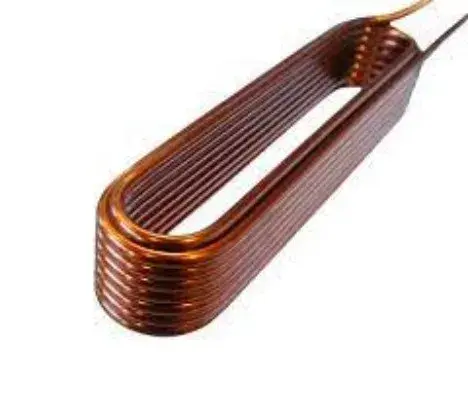Despite its simple appearance, enamelled wire is a sophisticated product. The enamelled wire must withstand the mechanical stresses due to bending and stretching during coil winding, which is typically executed at the fastest speed possible in order to increase productivity.
Also, during nominal operation (and overload events) the mechanical forces, thermal stress, as well as chemical and environmental conditions require certain level of performance from the wire and its insulation, so that a reasonable life time can be expected.
The frequently used grades have their technical parameters standardised by international standards such as: IEC 603177), NEMA MW10008), and JIS C32029).
For example, for round enamelled wires the following parameters are defined or controlled: 10)11)
Apart from electrical insulation, the enamel also provides protection against corrosion or oxidation of the copper wire.
Typical electric strength of the enamel is around 170-220 V/μm, which is why a relatively thin layer of enamel can withstand significant voltage. For example, the 0.375 mm wire with the cracked enamel shown above has a voltage breakdown of 4.35 kV despite the enamel thickness being only 0.0275 mm.
The life span of electrical insulation is related to the temperature at which it is used. A typical minimum lifetime of enamel in its nominal temperature is at the order of 20 000 hours.
There are several nominal temperature ranges (thermal classes), listed with the basis on which the enamel is made, for example:
The presence of enamel impedes soldering (as compared to bare copper). For this reason, the chemical properties of enamel are optimised in order to facilitate soldering (especially for the enamels rated up to 200°C), which can be achieved by direct application of heat and solder to the outer surface of the enamelled wire.
The enamel will dissolve or boil off, exposing the copper underneath, and to some extent providing even some fluxing or self-fluxing properties. This is sometimes indicated in the name of the product, for example “Polysol” of Elektrisola.16)
The enamel rated for higher temperatures does not support the action of direct soldering through to the copper. Instead, the coating has to be removed by some mechanical means first.17)
There are also special grades of enamel for specific applications. For example, there is “self-bonding” type of enamel which has an additional layer of adhesive.18)
After a winding is made, the formed wires can be made to adhere to each other, by activating the adhesive with a solvent or warming up the assembly. With the thermal method the coil can be warmed up (depending on the type of the bonding agent), typically to around 120-220°C by: blowing hot air on the assembly, putting it in an oven, or by the “resistive method” (passing current through the coil to heat it up).
With the solvent method, the adhesive can be activated by applying (brushing, spraying or wicking) a suitable solvent such as denatured alcohol (ethanol or methanol), during the winding process. The solvent may be diluted with water, as required, but the strength of bonding is reduced.19)
Enamel wire is typically made in three “grades”, with the number related to the thickness of enamel (sometimes assumed to be the number of coating layers, but in reality there can be more layers):
Grade 3 of enamelled wire should not be confused with triple-insulated wire.
For example, a comparison of the dimensions for 0.5 mm enamelled wire is as shown in the table below. The higher grades have significantly increased voltage breakdown at the expense of thicker insulation and outer diameter of the wire (so fewer wires can fit into the same cross-section area of the winding).
| Manufacturer data for 0.5 mm nominal diameter enamelled wire (circular cross-section)20) | |||||
|---|---|---|---|---|---|
| Grade | Min. diameter (mm) | Max. diameter (mm) | Elongation (%) | Breakdown voltage (V) | Tension (cN) |
| Grade 1 | 0.524 | 0.544 | 28 | 2400 | 1287 |
| Grade 2 | 0.545 | 0.566 | 28 | 4600 | 1287 |
| Grade 3 | 0.567 | 0.587 | 28 | 7000 | 1287 |
The production process involves several stages:
 The Critical Role of Winding C
The Critical Role of Winding C
 PEW/155 QZL-1 Degree 0.25mm- 5
PEW/155 QZL-1 Degree 0.25mm- 5
 Magnet Wire Information
Magnet Wire Information
 Enameled Copper Strap Coils Fo
Enameled Copper Strap Coils Fo